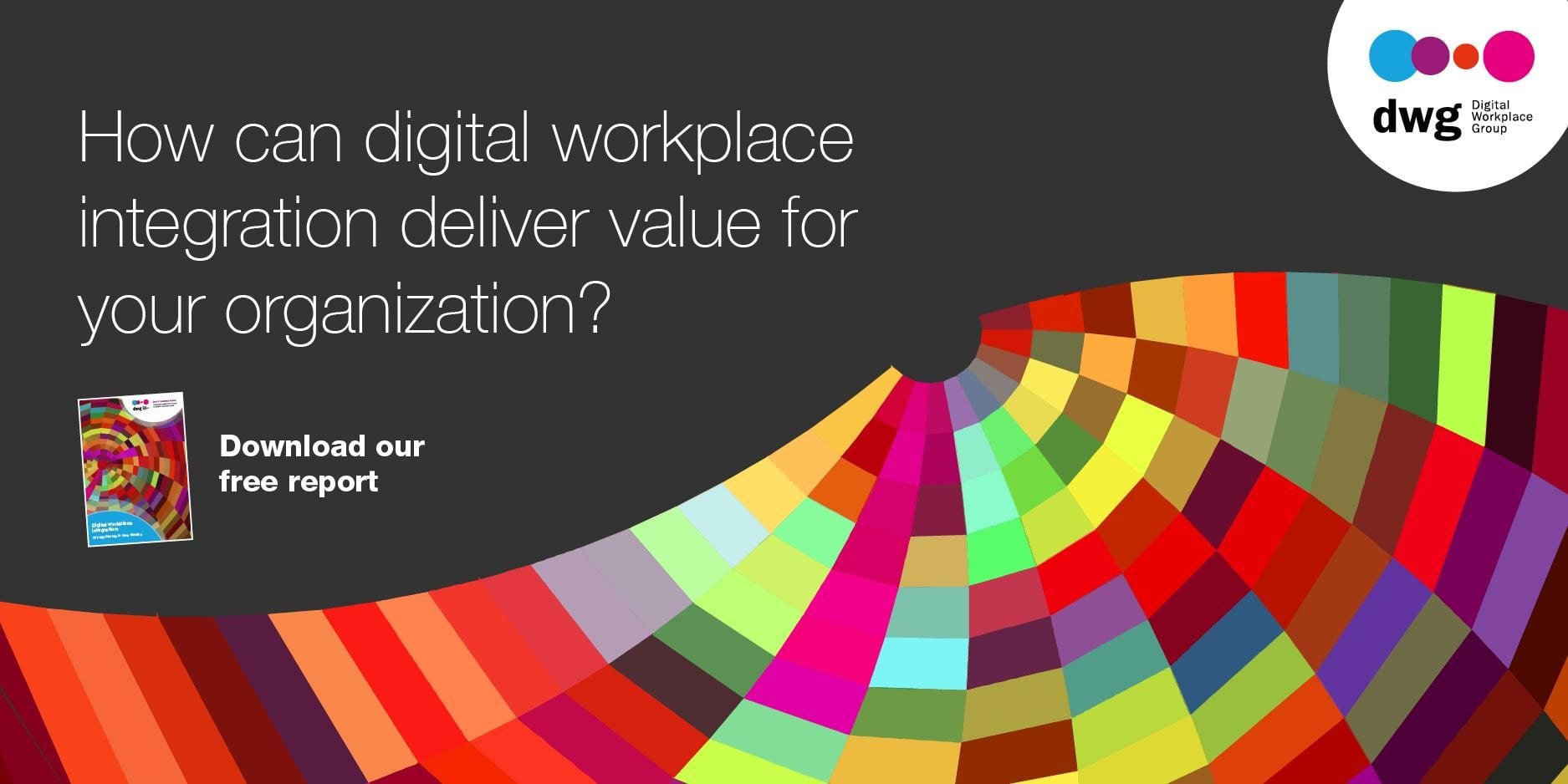Five key approaches for a successful integrated digital workplace
 When most organizations develop a digital workplace strategy, or design an intranet which seeks to be a “front door” to that wider digital workplace, they are almost always seeking to create a more integrated experience of disparate systems, data and content. This can add value for employees and organizations in many different ways – from driving efficiencies and unlocking insights, to increasing adoption and encouraging use of particular systems.
When most organizations develop a digital workplace strategy, or design an intranet which seeks to be a “front door” to that wider digital workplace, they are almost always seeking to create a more integrated experience of disparate systems, data and content. This can add value for employees and organizations in many different ways – from driving efficiencies and unlocking insights, to increasing adoption and encouraging use of particular systems.
But creating an integrated digital workplace experience has its challenges. In our 2017 State of the Digital Workplace Report1, “siloed systems and data” was one of the top five digital workplace challenges mentioned by respondents to our survey. And, with organizations, technology, employee needs and systems used always very fluid, creating an integrated experience that is also sustainable takes considerable thought and planning.
The latest report from DWG’s research programme examines what needs to be done in order to create a successful integrated digital workplace. The report, which is free to download, looks at key approaches you need to take, foundations that must be built and types of interface to consider.
The report also shows how two very different organizations – Liberty Mutual and The University of Liverpool – are building successful integrated digital workplaces, albeit in quite different ways.
Here are five key approaches that can help unlock the value of digital workplace integration.
1. Work on the foundations for more sustainable integration
All too often, organizations rush into creating the interfaces and experiences for users to access the digital workplace before completing the foundational work that will make those interfaces work in a sustainable way. The portfolio of applications in use within any organization is in a constant state of flux and work in the background will be needed to enable new systems to be integrated more easily into the digital workplace. These “foundations” can include:
- clarifying the right strategy
- adopting a governance framework
- consistent information management and data standards
- getting the right technical architecture
- following an internal API strategy
- aiming for single sign-on
- appropriate stakeholder and change management.
Spending time on all of the above is critical to the integrated digital workplace.
2. Plan for a range of interfaces and experiences
There is certainly more than one interface that delivers an integrated view of applications across the digital workplace. Interfaces and experiences can include intranet homepages, “classic” dashboards, search interfaces, navigation, notifications and workflow, users’ desktops, users’ mobile devices, app stores, interfaces within applications or environments such as Office 365, reporting dashboards and even chatbots!
It’s important to acknowledge the wide scope of the digital workplace and to plan to introduce or improve a range of different interfaces and experiences. These interfaces perform different functions including acting as the point of entry into systems and being the place to find the right application, view information and data outputs from systems, complete tasks and access notifications. There are also interfaces for reporting and, in the app store, a place to download applications.
3. Use personalization to power integration
An integrated digital workplace experience has the potential to be overwhelming. It needs to be highly relevant for individuals for them to want to use it every day. Personalization (often based on role, division/function and location) can help ensure that any unwanted applications, data and content are filtered out for different groups. The ability for the individual to configure their own experiences for everyday use can also help ensure the integrated digital workplace retains value.
Personalization also drives other elements of an integrated digital workplace, such as the ability to surface individual data which can be locked in systems – for example, the amount of annual leave an individual has owing to them. It can also allow for relevant transactions, such as requesting more annual leave.
4. Don’t compromise on the user experience
When building up an integrated digital workplace, there has been a tendency in the past to build a single monolithic integrated system, which aims to do everything for every user. Although the development behind these systems can be very clever, in practical terms, it often results in a compromise to the user experience and can end up being overwhelming. This, in turn, impacts adoption. Nobody wants to use a system that is cluttered and confusing. Users prefer a simpler experience that helps them complete tasks quickly and efficiently.
Moreover, these monolithic systems are both complex and interconnected, and it can become very difficult (and expensive) to make changes to them. They simply cannot keep up with the pace of change within the digital workplace.
5. Liberate, integrate and innovate!
One of the most valuable approaches for digital workplace integration is to combine data from disparate systems into dashboards, which not only helps people in their everyday work, but also aids decision-making and reveals insights.
Organizations following this approach are:
- liberating data so it can be easily exported from and imported into different applications
- integrating data where this has value, for example, in reporting
- allowing others to innovate by opening up access via internal APIs.
In the report, it’s exciting to see how both the University of Liverpool and Liberty Mutual are following this principle.
Integration must have value
Creating a seamless and integrated experience for the digital workplace requires work behind the scenes and some overarching approaches to make sure this is both successful and sustainable. It is crucial never to lose sight of the importance of crafting a great user experience, ensuring future integration is manageable and delivering business value.
Get access to 70 best practice digital workplace reports
DWG’s best practice Research Library contains 70 reports covering key areas relating to intranets and the digital workplace mentioned in this post, including: strategy and governance, personalization, user experience and change management.
Find out what’s in the library and new research that’s coming up. Please contact Nancy Goebel to discuss how to gain access to the library with DWG membership.
Digital workplace
Integration
Arrange a call
to learn more
Footnotes
1. 2017 State of the Digital Workplace Report
Categorised in: Digital workplace, Research reports
 Download free report »
Download free report »
